 W
WThe Abondance is a cross breed of cattle which originated in the high valleys of Haute-Savoie, France.
 W
WThe Albera is an endangered breed of small cattle indigenous to the Albera Massif, which divides Catalonia from France and lies partly in the comarca of Alt Empordà in the Catalan province of Girona, and partly in the comarca of Vallespir in the French département of Pyrénées-Orientales. The cattle are highly resistant to cold, though susceptible to heat, and are well adapted to the steep terrain of the massif.
 W
WThe Armoricaine or Armorican is an endangered French breed of domestic cattle. It originated in Brittany in the nineteenth century. It has a red coat with white markings, and has short horns.
 W
WThe Aubrac is a French breed of domestic beef cattle. It originates on the Plateau de l'Aubrac in the Massif Central in central southern France, from which it also takes its name. It has a wheat-coloured coat and dark hooves, switch, muzzle and eyes.
 W
WThe Aure et Saint-Girons or Casta is an endangered French breed of domestic cattle. The breed name derives from its two principal areas of origin, the Vallée d'Aure in the département of the Hautes-Pyrénées, and the area of Saint-Girons and the Couserans in the Ariège. The name "Casta" derives from its chestnut colour.
 W
WThe Bazadaise or Grise de Bazas is a French breed of beef cattle. It takes its name from the town of Bazas in the département of the Gironde, in the Nouvelle-Aquitaine region of south-western France, and originates in the low-lying areas to the south of the River Garonne near that town. A festival, the Fête des Boeufs Gras, is held each year in Bazas to present fattened Bazadaise stock.
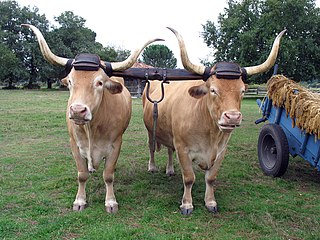 W
WThe Béarnaise is a French breed of domestic beef cattle. It originates in the area of the traditional province of Béarn, in the east of the département of Pyrénées-Atlantiques, in the northern Pyrénées in south-west France. It was merged with other breeds in 1920 to form the Blonde des Pyrénées, which in turn was fused with the Blonde de Quercy and Garonnaise breeds to create the Blonde d'Aquitaine in 1962.
 W
WThe Betizu is a breed of small mountain cattle which live in a semi-feral state in some mountainous parts of the Basque Country in both Spain and France. It is classified as an endangered breed by both the Ministerio de Agricultura, Pesca y Alimentación, the agriculture ministry of Spain, and by the Conservatoire des Races d'Aquitaine in France.
 W
WThe Bleue du Nord is a French breed of dual-purpose cattle from the former region of Nord-Pas-de-Calais in the north-east of the country, on the border with Belgium. It shares the origins of the Belgian Blue, but unlike that breed is selectively bred both for meat and for dairy use. The "double-muscling" characteristic of the Belgian Blue, caused by a genetic myostatin deficiency, is present also in the Bleue du Nord, but to a limited and controlled extent.
 W
WThe Blonde d'Aquitaine is a modern French breed of large domestic beef cattle. It was created in 1962 by merging three blonde draught breeds of south-western France, the Blonde des Pyrénées, the Blonde de Quercy and the Garonnaise. Since about 1970 it has been selectively bred specifically for beef production. It is the third-most numerous beef breed of France, after the Charolais and the Limousin. It has been exported to many countries round the world.
 W
WThe Bretonne Pie Noir is breed of small dairy cattle from Brittany in north-western France. It originates from Cornouaille and the Pays de Vannes in the départements of Finistère and Morbihan. Due to its small size, modest requirements, good productivity and ability to exploit poor and marginal terrain, it was well suited to traditional Breton agriculture. A herdbook was established in 1886. The breed was in the past numerous; at the beginning of the twentieth century there were about 500,000. Numbers fell drastically during that century, and in 1976, when about 15,000 remained, a breed conservation plan was begun, the first such for any breed of cattle.
 W
WThe Bruna dels Pirineus, Spanish: 'Bruna de los Pirineos', is a breed of cattle from the south-eastern Pyrenees, in the northern part of Catalonia. It derives from cross-breeding of local cattle with Swiss Braunvieh stock imported in the nineteenth century through France and through the Val d'Aran. It is distributed throughout the northern comarcas of Catalonia, Alta Ribagorça, Alt Urgell, Berguedà, Cerdanya, Pallars Jussà, Pallars Sobirà, Ripollès, Solsonès and Val d'Aran. The Bruna dels Pirineus constitutes about 80% of the beef herd of Catalonia.
 W
WThe Camargue is a breed of domestic cattle native to the Camargue marshlands of the river delta of the Rhône in southern France. It used for the traditional sport of course camarguaise, a kind of bloodless bull-fight, but not for the corrida, Iberian-style bull-fighting. It is one of two cattle breeds raised in semi-feral conditions in the Camargue; the other is the Brava or Race de Combat, a fighting breed. Since 1996 it has been officially known as the Provençal: Raço di Biòu.
 W
WThe Charolais or Charolaise is a French breed of taurine beef cattle. It originates in, and is named for, the Charolais area surrounding Charolles, in the département of Saône-et-Loire, in the Bourgogne-Franche-Comté region of eastern France. Charolais are raised for meat; they may be crossed with other breeds, including Angus and Hereford cattle.
 W
WCorsican Cattle or Corsicana is a French cattle breed.
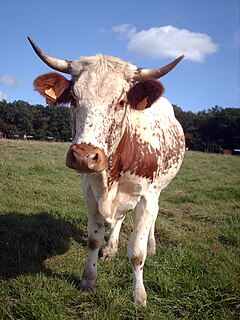 W
WThe Ferrandaise is an endangered French breed of domestic cattle from the département of Puy-de-Dôme, in the Massif Central mountains of Auvergne, in central France. It is named for the city and commune of Clermont-Ferrand, the capital of Puy-de-Dôme.
 W
WThe Froment du Léon is an endangered French breed of dairy cattle from the coastal region of northern Brittany, in the north-west of France. It is named for the historic Viscounty of Léon, in the départements of Côtes-d'Armor and Finistère in the extreme north-west of Brittany. It is valued for the quality of its milk, which is yellow and high in fat, and is particularly suitable for making into butter.
 W
WGascon cattle is a breed of cow. Two different types of this breed of cattle are: à muqueuses noires and aréolé. These were combined in 1955 into a single herdbook, but in 1999 they were once again made two different breeds.
 W
WThe Limousin, French: Limousine, is a French breed of beef cattle from the Limousin and Marche regions of France. It was formerly used mainly as a draught animal, but in modern times is reared for beef. A herd book was established in France in 1886. With the mechanisation of agriculture in the twentieth century, numbers declined. In the 1960s there were still more than 250 000 head, but the future of the breed was not clear; it was proposed that it be merged with the other blonde draught breeds of south-western France – the Blonde des Pyrénées, the Blonde de Quercy and the Garonnaise – to form the new Blonde d'Aquitaine. Instead, a breeders' association was formed; new importance was given to extensive management, to performance recording and to exports. In the twenty-first century the Limousin is the second-most numerous beef breed in France after the Charolais. It is a world breed, raised in about eighty countries round the world, many of which have breed associations.
 W
WThe Lourdaise is an endangered French breed of domestic cattle. It is named for the town of Lourdes, in the Hautes-Pyrénées département of the region of Occitanie, and originated in the surrounding country, particularly in the cantons of Argelès, Bagnères-de-Bigorre and Ossun. It was formerly a triple-purpose breed, kept for its milk, for its meat and for draught work. It was widely distributed in the Pyrénées of south-western France. It came close to extinction in the 1980s, but has since recovered following conservation efforts. It remains critically endangered.
 W
WThe Maine-Anjou is a French breed of domestic cattle, raised mainly in the Pays de la Loire region in north-western France. It was created in the nineteenth century in the historic province of Maine by cross-breeding the local Mancelle dairy cattle with Durham stock from Britain, and was at first called the Durham-Mancelle. In France it has been known since 2004 as the Rouge des Prés, but the Maine-Anjou name continues to be used elsewhere. It was formerly a dual-purpose animal, raised both for meat and for milk, but is now principally a beef breed.
 W
WThe Mirandaise is an endangered French breed of domestic cattle from the département of the Gers, in the historic region of Gascony, now part of the region of Occitanie in south-western France. It is named for the commune of Mirande, in the Gers. The Mirandaise is characterised by an unusual colouration of the areas around the anus and vulva, which are dark in the centre and pale towards the edges. This areola has given the breed its other name, the French: Gasconne aréolée. It is a different breed from the smaller Gasconne, which does not have the same colouration.
 W
WThe Montbéliarde is a breed of red pied dairy cattle from the area of Montbéliard, in the département of Doubs, in the Bourgogne-Franche-Comté region of eastern France. It is used mainly for dairying and particularly for cheesemaking.
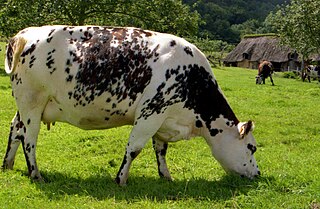 W
WThe Normande is a breed of dairy cattle from the Normandy region of north-west France. It is raised principally for its milk, which is high in fat and suitable for making butter and cheese, but also for its meat, which is marbled and good-flavoured. It is a world breed: it has been exported to many countries and is present on all continents.
 W
WThe Parthenaise is a French cattle breed. It is named for the town of Parthenay in the département of Deux-Sèvres, in the Nouvelle-Aquitaine region of western France. It was formerly a triple-purpose breed, raised for milk, meat and draught work, but is now raised mainly for beef.
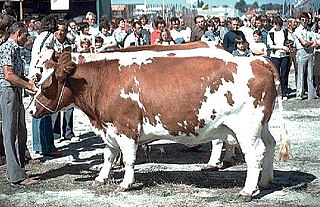 W
WThe Pie Rouge des Plaines is a modern French breed of dairy cattle. It was created in about 1970 by cross-breeding the traditional Armorican cattle of Brittany, in north-western France, with red-pied cattle of the Dutch Meuse-Rhine-Yssel and German Deutsche Rotbunte breeds.
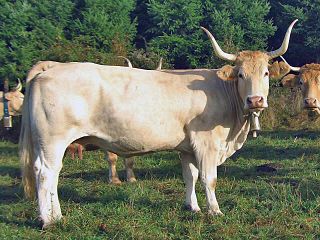 W
WThe Pirenaica, Basque: Behi-gorri, is a breed of beef cattle indigenous to the Pyrenees of north-eastern Spain. It is distributed mainly in the autonomous communities of Navarre and the Basque Country, but is present in much of the northern part of the country. It is well adapted to the mountainous terrain and humid climate of the area. It came close to extinction in twentieth century, but is not now at risk.
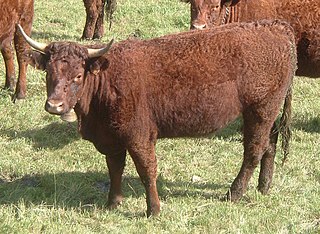 W
WThe Salers is a breed of cattle which originated in Cantal in the Massif Central of France.
 W
WTarentaise cattle descend from the domestic cattle of the Tarentaise valley in France where they were isolated from other breeds for many thousands of years. The cattle adapted in such a way as to allow them to exist in high altitudes and be able to range in very steep and rough terrain to forage. They are used in France today to produce the cheese with a distinct flavor that comes from the high alpine villages of the Tarentaise, Beaufortain and Maurienne valley. These cattle have found special niches around the world in commercial cattle grazing and calving. In the USA these cattle are used primarily for producing crossbred cows distinctly suited for tough rangeland conditions and higher elevations. They are also bred for the beauty of their markings and their docile demeanor.